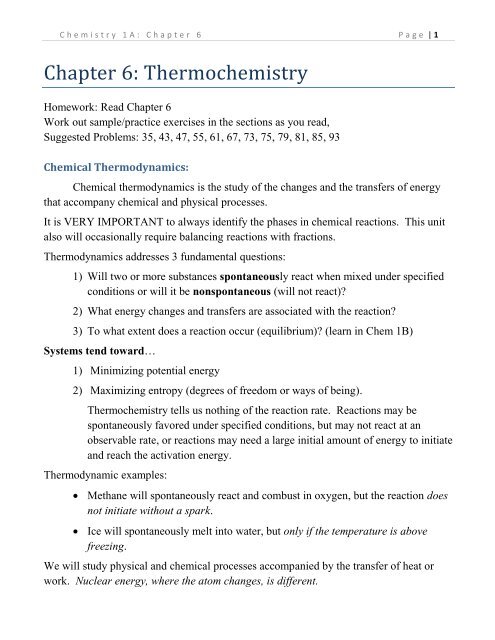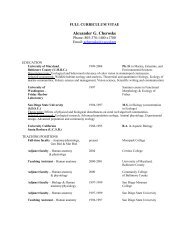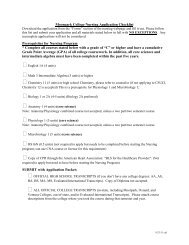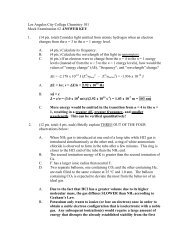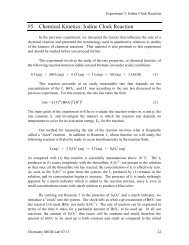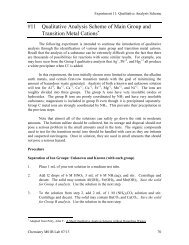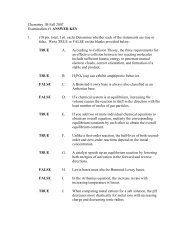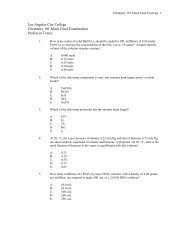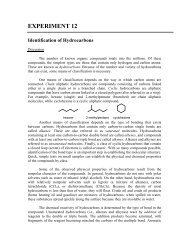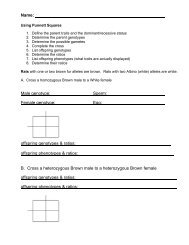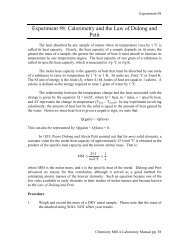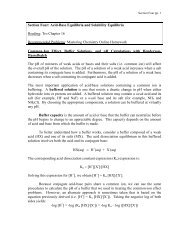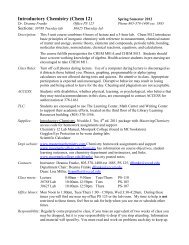Unit 3: Chapter 6: Thermochemistry - Moorpark College
Unit 3: Chapter 6: Thermochemistry - Moorpark College
Unit 3: Chapter 6: Thermochemistry - Moorpark College
You also want an ePaper? Increase the reach of your titles
YUMPU automatically turns print PDFs into web optimized ePapers that Google loves.
C h e m i s t r y 1 A : C h a p t e r 6 P a g e | 1<strong>Chapter</strong> 6: <strong>Thermochemistry</strong>Homework: Read <strong>Chapter</strong> 6Work out sample/practice exercises in the sections as you read,Suggested Problems: 35, 43, 47, 55, 61, 67, 73, 75, 79, 81, 85, 93Chemical Thermodynamics:Chemical thermodynamics is the study of the changes and the transfers of energythat accompany chemical and physical processes.It is VERY IMPORTANT to always identify the phases in chemical reactions. This unitalso will occasionally require balancing reactions with fractions.Thermodynamics addresses 3 fundamental questions:1) Will two or more substances spontaneously react when mixed under specifiedconditions or will it be nonspontaneous (will not react)?2) What energy changes and transfers are associated with the reaction?3) To what extent does a reaction occur (equilibrium)? (learn in Chem 1B)Systems tend toward…1) Minimizing potential energy2) Maximizing entropy (degrees of freedom or ways of being).<strong>Thermochemistry</strong> tells us nothing of the reaction rate. Reactions may bespontaneously favored under specified conditions, but may not react at anobservable rate, or reactions may need a large initial amount of energy to initiateand reach the activation energy.Thermodynamic examples: Methane will spontaneously react and combust in oxygen, but the reaction doesnot initiate without a spark. Ice will spontaneously melt into water, but only if the temperature is abovefreezing.We will study physical and chemical processes accompanied by the transfer of heat orwork. Nuclear energy, where the atom changes, is different.
C h e m i s t r y 1 A : C h a p t e r 6 P a g e | 2Example 1:Systems tend toward minimizing potential energy and maximizing entropy.Identify the side that minimizes the potential energy. Identify the side that maximizesways of being (entropy). Assume the same temperature and atmospheric pressure foreach.a) Top of waterfall or Bottom of waterfallb) 1 mole H 2 molecules or 2 mole of H atomsc) H 2 O (g) at 100°C or H 2 O (l) at 100°CNature of Energy:Energy is the capacity to do work or transfer heat. Energy (a quantity) can exist ina variety of forms and can be transformed from one form to another. It is measuredby the amount of work done, usually in joules or watts. Chemistry generally usesjoules. SI units of energy: 1 Joule = 1 kg m 2 /s 2Energy Conversions1 calorie (cal) = 4.184 joules (J) (exact)1 Calorie (Cal, food) = 1000 cal = 1 kcal = 4184 J1 kilowatt-hour (kWh) = 3.60 x 10 6 JSome Forms of Energy:• Electricalkinetic energy associated with the flow of electrical charge• Mechanicalkinetic energy associated with moving parts• Heat or thermal energykinetic energy associated with molecular motion• Light or radiant energykinetic energy associated with energy transitions in an atom• Nuclearpotential energy in the nucleus of atoms• Chemicalpotential energy due to the structure of the atoms, the attachment betweenatoms, the atoms’ positions relative to each other in the molecule, or themolecules, relative positions in the structure
C h e m i s t r y 1 A : C h a p t e r 6 P a g e | 3Energy can be classified into two major categories, potential and kinetic.Potential Energy is the energy by virtue of its position of composition.a) For an object that has height, potential energy is the mass x gravity (9.8 m/s 2 )x height; E p = mgh.b) Another form is electrostatic potential energy from interactions with chargedparticles; E el = kQ 1 Q 2 /d, where k = 8.99 x 10 9 J m/C 2 and C is coulomb thatis a unit of charge, Q is charge, and d is distance. Like charges repel andopposites attract.c) Potential energy also comes from the arrangement of chemical compositions.When bonds break and new ones form in a chemical reaction, the energychange generally is due to the changes in potential energy/composition.Kinetic Energy is the energy of motion. For a moving object kinetic energy is halfthe mass x velocity squared; E k = ½ mv 2Example 2: What is the potential energy of a 400 g ball on top of a building thatis 30.0 m tall?Example 3: What is the kinetic energy of a 400 g ball moving at 30.0 m/s?Some <strong>Thermochemistry</strong> terms…System: the portion we studySurroundings: everything else affected by the portion we studyUniverse: the combined system plus surroundings. In the lab experiments ouruniverse will be a calorimeter and its contents.
C h e m i s t r y 1 A : C h a p t e r 6 P a g e | 5Internal Energy, E or U; the sum of all the kinetic and potential energies of allcomponents. This includes all motions of vibration, rotation, movement throughspace of the object, its atoms, nuclei, and even including subatomic particles likeelectrons. We cannot truly measure all of this, so we generally try to solve for thedifference or change in internal energy in our studies. E = E final – E initialWhen solving for E we work with a constant volume system. <strong>Unit</strong>s are generallykJ/mol. When the energy is measured in J or kJ for a particular system, q v may beused.Work, w; Work is force acting over a distance, (work = force x distance), theenergy used to cause an object to move. Pressure-Volume work involves thecompression or expansion of gases.Work = -PV ; if using atm and liter: convert to J with R/R (101.3 J/L atm)Work = -nRT; use the R with joules: R = 8.314 J/mol KFor most reactions the energy from work is quite small.Expansion work is (-); work done by the system on the surroundings.Compression work is (+); work done on the system by the surroundingsRelating together; q v = q p + w , or it can be written E = H + wEndothermic: a process that absorbs heat (+)Exothermic: a process that releases heat (-)State Function: a property thatdepends only on the presentstate and not the path the systemtook to reach the state. In<strong>Thermochemistry</strong> statefunctions are generallycapitalized. (Notice work is asmall w and is not a statefunction)Examples of state functionsinclude: E, H, V, P, T.
C h e m i s t r y 1 A : C h a p t e r 6 P a g e | 6Example 6:a) As 1.00 mole of H 2 O gas becomes H 2 O liquid at 100°C, 40.7 kJ of energyare transferred at 1.00 atm pressure. What is the enthalpy sign for thisconversion? Is this process endothermic or exothermic?b) During this process at 1.00 atm pressure, the volume decreases from 30.6liters down to 18 ml. Solve for the work in L atm and in J. Is the sign ofwork positive or negative? Is work done on the system by thesurroundings (compression) or by the system on the surroundings(expansion) ?Example 7:Predict the sign for work, determine if the system is expanding or compressing andstate if work is done on or by the system.a) 2 NO (g) + O 2 (g) 2 NO 2 (g)b) 2 C 4 H 10 (g) + 13 O 2 (g) 10 H 2 O (l) + 8 CO 2 (g)Example 8:Which of the following are state functions and which are not state functions ?a) The temperature of an ice cube.b) The enthalpy of fusion for water.c) The time to travel 1-mile
C h e m i s t r y 1 A : C h a p t e r 6 P a g e | 7Enthalpies of Reaction:Thermochemical Equations with Enthalpy:1) Always include phases (s, l, g, aq) of substances. Energy varies with phase.2) Assume temperature is constant for reactants at the beginning and products atthe end, even though the temperature may change during the reaction. H isthe energy required to return a system to the starting temperature at thecompletion of the reaction.3) Reactions may be balanced using fractions and not whole numbers.4) Enthalpy (H) is an extensive property. When a reaction is doubled, the enthalpy doubles.5) When a reaction is reversed the enthalpy changes its sign.6) Change in enthalpy may be experimentally determined using calorimeters.7) The ° indicates standard conditions (1 atm and 25°C).8) Scientists arbitrarily agreed to set a zero H f ° defined as the enthalpy offormation of elements in their most common form under standard stateconditions. All other H f ° values are calculated from these9) Enthalpy of formation H f °) is the formation of 1 mole of a compound fromits elements in their most common form under standard conditions.10) Tabulated enthalpy (H f °) values are found in reference sources.Example 9:Given: 4 NH 3 (g) + 5 O 2 (g) 4 NO (g) + 6 H 2 O (g); H = -906 kJ/mola) Is the reaction above endothermic or exothermic?b) How many grams of NH 3 gas are required to produce 374 kJ of energy?c) What is the enthalpy term for… 2 NO (g) + 3 H 2 O (g)2 NH 3 (g) + 5/2 O 2 (g)
C h e m i s t r y 1 A : C h a p t e r 6 P a g e | 8Calorimetry:Using the First Law of Thermodynamics and a calorimeter it is possible to solve forquantitative energy transfers.Heat capacity (C) is the energy required to raise an object by 1°C or 1K (kJ/°C)Specific heat capacity (C or s) is energy to raise one gram of a specific substance by1°C or 1K (units: J/g°C)Molar heat capacity (J/mol °C)Q gain = - Q lostQ calorimeter = - Q reactionCoffee- cup calorimetry: pressure is constant; Q p = mcT for calorimeterBomb calorimetry: volume is constant; Q v = CT for calorimeterIt is important to remember that the system you are studying is going to have equalenergy, but opposite sign when compared to what happens in the calorimeter.WATCH THE SIGNS!Example 10:A 7.82 g sample at 99.2C is added to 30.0g of water at 22.10C in a coffee-cupcalorimeter. The final temperature is 24.20C. The specific heat capacity of water is4.184 J/gC.a) Solve for the specific heat of the metalb) Identify the metal. (choices: Al = 0.903 J/gC,Fe = 0.449 J/gC, Pb = 0.128 J/gC)c) Test the Law of Dulong and Petit which states that the molar heat capacity ofelements are all approximately 25 J/molC by solving for the molar heat capacitiesof Al, Fe, Pb.
C h e m i s t r y 1 A : C h a p t e r 6 P a g e | 9Example 11:A 0.900-g sample of glycerol trilaurate (a typical fat, C39H74O6) was burned inexcess oxygen in a bomb calorimeter. The temperature increased from 24.13°C to26.93°C. The heat capacity of the bomb calorimeter is 12.0 kJ/°C.a) Balance the combustion reaction for 1 mole of the fat.C39H74O6 (s) + O2 (g) CO2 (g) + H2O (l)Fatb) In a bomb calorimeter identify what isconstant (P or V) and identify if thisexperiment measures heat in enthalpy (H)or internal energy (E)?c) Solve for the heat of reaction in the bombfor the combustion of the fat in units of kJ/gand kJ/mol. Label your answer as E orH as appropriate.d) Calculate the amount of dietary Calories (kcal) per gram of fat.e) Calculate the theoretical work in kJ/mol fat under standard conditions,25°C for the reaction written in part (a).f) Solve for the theoretical enthalpy for the combustion of 1 mole of this fat atstandard conditions.
C h e m i s t r y 1 A : C h a p t e r 6 P a g e | 10Example 12:Before the days of refrigerators and icemakers, drinking water in hot countries wasoften cooled by storage in clay pots. Evaporation of water through the pot cooledthe remaining water. How many grams of water must evaporate to cool 946 grams(1 quart) of water from 33.5°C to 19.2°C? For water, specific heat is 4.184 J/g°C;H vap is 44.0 kJ/mol.Enthalpies of Formation:Enthalpy (or Heat) of Formation,H° f : The enthalpy change associated with theformation of one mole of a substance from its constituent elements in their mostcommon form and state. H° f , the f represents formation and ° indicates thestandard state conditions of 25°C and 1 atm pressure.Example 14:Fix the following to make it an enthalpy of formation equation…2K (l) + H 2 (g) + C (diamond) + O 3 (g) KHCO 3 (s)Example 15:Write balanced equations that describe the formation of the following compoundsfrom their elements in their standard states. Use the appendix to obtain the valuesof their standard enthalpy of formation:a) NH 4 NO 3 (s)b) Ca 3 (PO 4 ) 2 (s)c) C 3 H 8 (g)
C h e m i s t r y 1 A : C h a p t e r 6 P a g e | 11Hess’s Law:Hess’s Law: If a reaction is carried out in a series of steps, H for the overallreaction will equal the sum of the enthalpy changes in the individual steps.It is possible to calculate enthalpy of a reaction in both the lab setting, and by usingreference sources. Enthalpy is an extensive property, so the amount is important. Ifa series of reactions are used to create an overall reaction, the enthalpy values canbe added to solve for the overall enthalpy of a reaction.H rxn = H a + H b + H cAny reaction can be broken down to formation reactions from elements. When thisis done we have…H° rxn = nH° f (products) - nH° f (reactants)Example 16: Use Hess’ Law to solve for the following…a) Use reference values of H° f to solve for the H° rxn below…C 3 H 8 (g) + 5 O 2 (g) 3 CO 2 (g) + 4 H 2 O (l)
C h e m i s t r y 1 A : C h a p t e r 6 P a g e | 12b) Calculate H rxn for… 3 H 2 (g) + O 3 (g) 3 H 2 O (g) GOALGiven: 3 O 2 (g) 2 O 3 (g) H = +284.6 kJ/molH f˚for H 2 O(g)H f = -241.8 kJ/molc) Calculate the standard enthalpy of formation (H° f ) of diborane gas, B 2 H 6 ,using the following…Given: 4 B (s) + 3 O 2 (g) 2 B 2 O 3 (s) H = -2509.1 kJ/mol2 H 2 (g)+ O 2 (g) 2 H 2 O (l) H = -571.7 kJ/molB 2 H 6 (g)+3 O 2 (g) B 2 O 3 (s)+3 H 2 O (l) H = -2147.5 kJ/molFoods and Fuels:Foods:Most of the energy we need for life comes from carbohydrates and fats in food.Carbohydrates (starches) decompose in our intestines into glucose (C 6 H 12 O 6 , bloodsugar). Sugars and carbohydrates have an average fuel value of 17 kJ/g (4 kcal/g)C 6 H 12 O 6 (s) + 6 O 2 (g) 6 CO 2 (g) + 6 H 2 O (l) H° = -2803kJFats also react with oxygen to give energy. This energy can be stored for later use.Fats average fuel value is 38 kJ/g (9 kcal/g).Fuels:Coal, petroleum and natural gas (fossil fuels) are the primary sources of energy. Inunits of energy per gram, the fuel value generally increases for hydrocarbons as thequantity of H is added.
C h e m i s t r y 1 A : C h a p t e r 6 P a g e | 13In the <strong>Unit</strong>ed States, each person uses over 10 5 kWh of energy per yearC(s) + O 2 (g) → CO 2 (g) H° rxn = −393.5 kJCH 4 (g) +2 O 2 (g) → CO 2 (g) + 2 H 2 O(g) H° rxn = −802.3 kJC 8 H 18 (g)+12.5 O 2 (g) → 8 CO 2 (g)+9 H 2 O(g) H° rxn = −5074.1 kJConvert these values to kJ/gram of fuel…C, CH 4 , C 8 H 18• Most of the energy for US citizenscomes from combustion of fossil fuels,combustible materials that originatefrom ancient life.• Fossil fuels cannot be replenished1 Quad = quadrillion British thermal units= 1.06 x 10 18 J.The US consumes close to 100 quads ofenergy annually.Example 17:Citizens of the world burn the fossil fuel equivalent of 7 x 10 12 kg of petroleum each year.a) If all 7 x 10 12 kg was in the form of octane, calculate the kg of CO 2 producedannually. C 8 H 18 (l) + O 2 (g) CO 2 (g) + H 2 O (l) (unbalanced)b) If the atmosphere currently contains 3 x 10 15 kg of CO 2 , how long will it taketo double the atmospheric carbon dioxide, assuming no photosynthesis orother reactions remove it?
C h e m i s t r y 1 A : C h a p t e r 6 P a g e | 14Global Warming:• CO 2 is a greenhouse gas which allows light from the sun to reach the earth, but doesnot allow the heat (infrared light) reflected off the Earth to escape back into outerspace. It acts like a blanket• CO 2 levels in the atmosphere are steadily increasing• Observations suggest that the average global air temperature has risen 0.6 °C in thepast 100 yrs.• Atmospheric models suggest that the warming effect could worsen if CO 2 levels arenot curbed• Some models predict that the result will be more severe storms, more floods anddroughts, shifts in agricultural zones, rising sea levels, and changes in habitatsRenewable Energy:• Our greatest unlimited supply of energy is the sun. Technologies are beingdeveloped to capture the energy of sunlight: parabolic troughs, solar power towers,and dish engines concentrate the sun’s light to generate electricity; solar energymay also be used to decompose water into H 2 (g) and O 2 (g); the H 2 can then be usedby fuel cells to generate electricity.H 2 (g) + ½ O 2 (g) → H 2 O(l)H° rxn = −285.8 kJ• Hydroelectric power• Wind power


